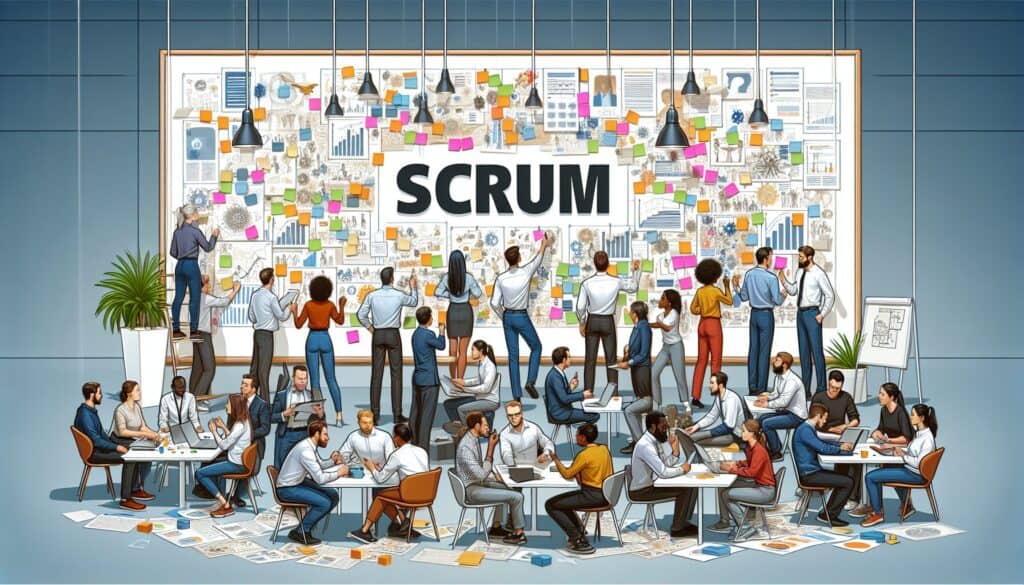An agile Rahmen for developing, delivering, and sustaining complex products, with an emphasis on iterative development, collaboration, and empirical Prozesskontrolle.
- Methodologien: Ergonomie
Gedränge

Gedränge
- Agile Methodik, Agile Produktentwicklung, Kontinuierliche Verbesserung, Iterative Entwicklung, Produkt-Backlog, Projektmanagement, Gedränge, Sprint-Planung, Teamarbeit
Zielsetzung:
Wie es verwendet wird:
- Work is done in short, time-boxed iterations called Sprints. A Product Owner manages a prioritized Product Backlog. A Gedränge Master facilitates the process for the Development Team. Regular events include Sprint Planning, Daily Scrums, Sprint Review, and Sprint Retrospective.
Vorteile
- Adaptable to changing requirements; Promotes collaboration and communication within the team and with stakeholders; Delivers working software frequently; Encourages continuous improvement and team empowerment.
Nachteile
- Requires a significant cultural shift and commitment from the team and organization; Can be challenging to implement correctly (ScrumBut); Effectiveness heavily depends on team dynamics and the Scrum Master's skill; May not be suitable for all types of projects.
Kategorien:
- Ideenfindung, Produktdesign, Projektmanagement
Am besten geeignet für:
- Managing complex product development, especially in software, where requirements are evolving or unclear, and iterative delivery is beneficial.
Scrum can be effectively utilized in various industries beyond software development, including manufacturing, healthcare, and product design, where teams face unpredictable challenges and seek to improve the quality of outputs through iterative cycles. In product design, for example, cross-functional teams consisting of designers, engineers, and marketers can use Scrum to create prototypes, adapt their designs based on user feedback, and ensure that the final product aligns closely with market needs. Industries such as automotive and aerospace have adopted Scrum principles to foster collaboration among diverse teams that must harmonize engineering, design, and user experience. Scrum thrives in project contexts that require rapid adaptation and ongoing stakeholder engagement, such as during the early stages of product lifecycle development, where customer needs and market conditions may shift quickly. Scrum encourages participation from various stakeholders—such as customers, end-users, and business analysts—enabling a comprehensive collection of requirements that improves product offerings. Sprints serve as effective checkpoints for assessing progress and realigning goals, while events like Sprint Reviews provide a platform for showcasing work to stakeholders and gathering constructive feedback, promoting a culture of continuous improvement. Large organizations utilizing Scrum can see enhanced efficiency and faster delivery timelines, as smaller teams within different departments coordinate their efforts while staying aligned with strategic objectives. The iterative nature of Scrum supports the practice of testing ideas early and often, which is particularly beneficial in a fast-paced market where innovation is a necessity.
Die wichtigsten Schritte dieser Methodik
- Conduct Sprint Planning to define the Sprint Goal and select items from the Product Backlog.
- Hold Daily Scrums for the Development Team to synchronize activities and plan work for the next 24 hours.
- Develop the product increment throughout the Sprint, ensuring adherence to quality standards.
- Facilitate the Sprint Review to demonstrate the completed increment and gather feedback from stakeholders.
- Conduct a Sprint Retrospective to reflect on the Sprint process and identify improvements for future Sprints.
Profi-Tipps
- Utilize metrics like velocity and burn-down charts to drive Sprint planning and evaluate team capacity for future Sprints.
- Encourage regular feedback from stakeholders by involving them in Sprint Reviews to ensure alignment with user needs and product goals.
- Implement a structured approach to Sprint Retrospectives by using techniques like "Start-Stop-Continue" to facilitate meaningful discussions and actionable improvement points.
Verschiedene Methoden lesen und vergleichen, Wir empfehlen die
> Umfassendes Methoden-Repository <
zusammen mit den über 400 anderen Methoden.
Ihre Kommentare zu dieser Methodik oder zusätzliche Informationen sind willkommen auf der Kommentarbereich unten ↓ , sowie alle ingenieursbezogenen Ideen oder Links.
Historischer Kontext
1960
1980
1983
1990
1995
2000
2010
1950
1980
1980
1986
1994
1995
2000
(wenn das Datum nicht bekannt oder nicht relevant ist, z. B. "Strömungsmechanik", wird eine gerundete Schätzung des bemerkenswerten Erscheinens angegeben)














Verwandte Artikel
Master Production Schedule (MPS)
Massenanpassung
Marketing-Trichter
Marketing-Audit
MAPO-Index (Bewegung und Unterstützung von Krankenhauspatienten)
Fertigungsressourcenplanung (MRP II)